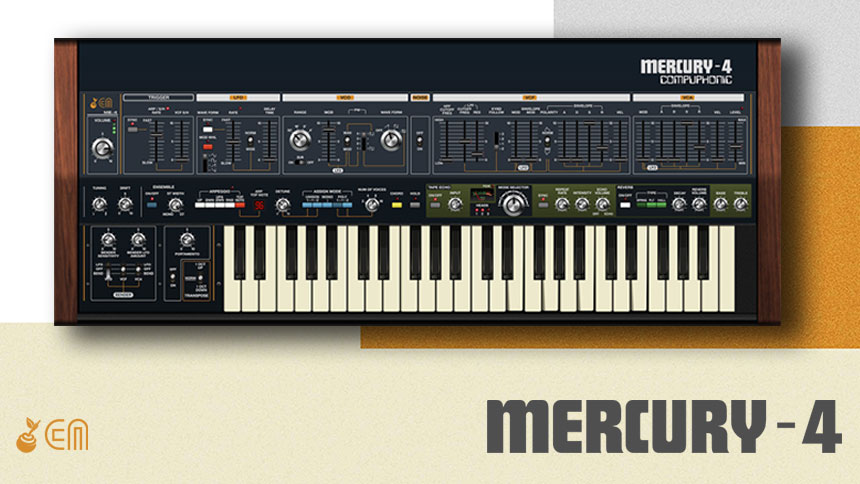
Cherry Audio's Mercury-4 is a polyphonic synthesizer based upon the classic Roland Jupiter-4 synthesizer. Originally released in 1978, it was the second synth made that combined voice-assign polyphony with digital patch storage (following the Sequential Circuits Prophet-5, released in 1978). When we say, "digital patch storage," we mean the ability to store and recall patch settings saved to a digital memory and recall them at the touch of a button. By "voice-assign polyphony," we're referring to instruments with a finite number of independent synthesizer voices (four, in this case) that digitally scan the keyboard and assign played notes to each synth voice. These days, voice-assign polyphony and digital patch storage are taken for granted, but this was a HUGE deal in the late 70s when options for polyphonic synthesis were mostly limited to paraphonic instruments (i.e. limited synthesis parameters and note envelopes weren't independent) derived from organ technology, and patch recall was generally limited to how fast you could twirl knobs and flick switches!
Arguably, the Jupiter-4 is something of an underdog. It was certainly overshadowed by the first voice-assign polysynth with digital patch storage - the Prophet-5. Not only was the Prophet first, but on paper, its specs are more impressive (five-voice polyphony vs. Jupiter's four, two oscillators per-voice vs. Jupiter's one, 40 or 128 user patch storage locations depending on revision vs. Jupiter-4's eight user patch locations, etc.). Appearing soon thereafter, Roland's later Juno-6/60/106 series also outshined the Jupiter-4 with greater polyphony, more user patch storage locations, superior tuning stability, and more.
But as is often the case, specs don't tell the whole story. Put plainly, the Jupiter-4 sounds fantastic, with a raw, raunchy tone not found in any of the other beloved Juno and Jupiter synths. Its analog oscillators (not DCO's) were implemented in a somewhat odd fashion, giving them a uniquely aggressive tone quality, the built-in sub oscillator adds girth, its oddly fast and deep LFO modulation capabilities allow it to create uniquely whacked out modular synth-like tones, and Roland's famous stereo chorus "ensemble" circuit is beautifully implemented, adding a boatload of width and dimension to the Jupiter-4's single-oscillator tones.
The original instrument had its share of caveats, including a meager eight user patch locations, no edit mode for stored patches (the front panel controls went dead when a factory or user preset was selected!), only four voices of polyphony, it weighed a ton (a portly 42 lb!), and its lack of autotune meant a cold breeze could send the whole thing careening out of tune. Cherry Audio's Mercury-4 addresses every one of these issues with up to 16-voice polyphony, infinite patch storage, easy patch editing, and much more. In addition to recreating the Jupiter-4's idiosyncratic oscillator and filter tonality, Mercury-4 precisely replicates the stereo ensemble effect and adds a spot-on "Space Echo"-style tape echo with multiple reverb modes.
Pre-Purchase Demo Mode

If you haven't purchased the full version of Mercury-4, it will run in demo mode. All functions will work, but inharmonic tones will occasionally sound (the LED next to Demo in the top toolbar will illuminate when the ugly tones are sounding). We've also added a handy button to make purchasing easy, so you've got no excuse! As you might expect, all this demo nonsense disappears once Mercury-4 is purchased.
Technical Assistance
Cherry Audio's unique online store and automatic updating should make operation a smooth experience, but if you run into any issues or have questions, you can discuss issues online at the Cherry Audio forums at:
https://forums.cherryaudio.com/viewforum.php?f=55
... or you can communicate directly with our dour and irritable outgoing and friendly tech support staff at: